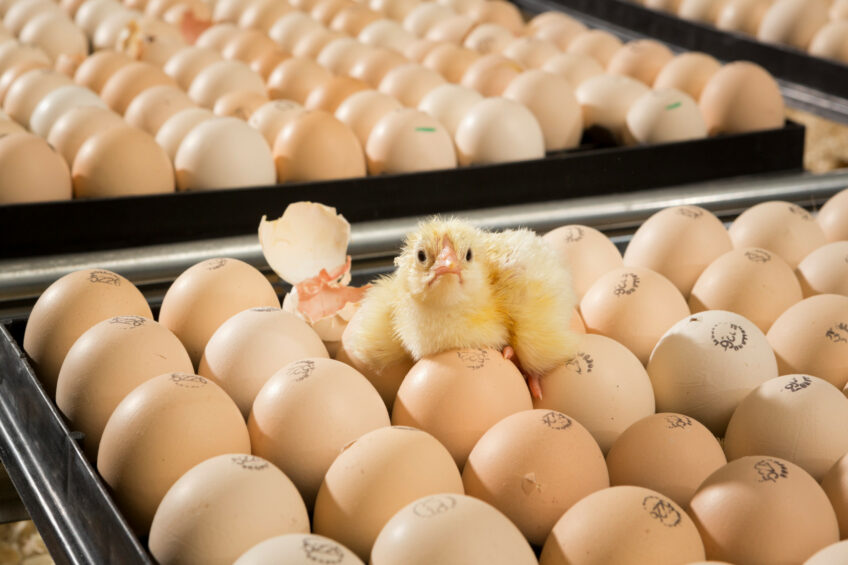In ovo feeding of bioactive compounds

This article will discuss the impact of in ovo feeding of various bioactive compounds, such as vitamins, amino acids and pre- and probiotics on poultry health and performance.
In modern poultry production systems, chicks have no access to feed during transportation between hatchery and production farm which affects their nutrient intake, gut microbiota, and immune system function. Application of in ovo feeding technology around day 12 or 17 to 18 of incubation provides early nutrients to embryos, stimulate gut microflora, and mitigate the adverse effects of starvation during pre-and post-hatch periods.

Impact of vitamins
- Research shows that in ovo feeding of ascorbic acid relieves the stress-related responses caused by heat exposure at the end of the incubation and enhances hatchability. In addition, ascorbic acid improves gut morphology by increasing villus height, villus width, and villus height to crypt depth ratio and lowers cholesterol. Another positive impact of in ovo feeding of ascorbic acid is increased post-hatch growth, enhanced average daily feed intake, improved leg muscle development and immunity, and increased antioxidant production in broilers.
- In ovo feeding of vitamin C increases plasma level of vitamin C in newly hatched chicks, reduces embryonic mortality, improves hatchability, reduces the stress response, and regulates immune function, according to several studies. Furthermore, vitamin C appears to enhance bone resistance and strength post-hatch by improving bone mineral content and density.
- Study results show that in ovo feeding of vitamin D increases calcium absorption from the gut, calcium reabsorption in the kidney, and osteoclasts formations and bone resorption. In addition, vitamin D increases breast meat yield and body weight by reducing the inflammatory response indicators post-hatch.

Impact of amino acids and their metabolites
- In ovo feeding of a combination of methionine and cysteine reduces the level of heat shock protein in eggs exposed to heat stress and improves total antioxidants capacity and lipid profile of hatched chicks appears from research.
- In addition, in ovo feeding of leucine metabolite contributes to cholesterol synthesis, maximises cell growth and function, decreases mortality, increases carcass yield, and improves protein metabolism in muscle, gut cells proliferation and differentiation, and villus surface area.
Impact of carbohydrates
- Research shows that in ovo feeding of dextrin increases the liver glycogen, elevates breast muscle size, and enhances the hatching process and early development.
- In ovo feeding of carbohydrates triggers mucin production and increases the villus surface area.
- In ovo feeding of glucose, fructose, and ribose in broiler eggs increases the expression of humoral immune-related genes, and the growth hormone.
Impact of prebiotics
In ovo feeding of prebiotics modulates early-life microbial community and improves gut morphology, nutrient uptake, and immune system function.
- It is also shown that in ovo feeding of galactooligosaccharide increases the relative abundance of Bifidobacterium spp. in the cecum and decreases the number of Lactobacillus spp. in the ileum of broilers. In addition, galactooligosaccharide inhibits immune responses induced by acute heat stress in slow-growing chickens, improves body weight, average daily feed intake, and feed conversion ratio, and reduced foot-pad dermatitis.
- In ovo feeding of chitooligosaccharide changes the caecal microbiome by increasing the abundance of polysaccharide-utilising bacteria and decreasing the opportunistic pathogenic bacteria.
- In ovo feeding of Raffinose family oligosaccharides in broilers enhances the number of Bifidobacterium bifidum and Lactobacillus acidophilus, increases meat oxidation, reduces the opportunistic pathogens such as clostridia and coccidia, and lowers the hatchability. Moreover, Raffinose family oligosaccharides increases the villus height and villus height to crypt depth ratio.
Impact of probiotics
- In ovo feeding of Bifidobacterium bifidum and Bifidobacterium longum has shown to improve live body weight, feed conversion ratio, and villi height without negative impacts on carcass traits, and liver and kidney functions.
- Also, in ovo feeding of lactic acid bacteria affects the development and diversity of gut microbiota and reduces gram-negative bacteria such as E. coli at hatch day and post-hatch.
- Moreover, in ovo feeding of Lactobacillus salivarius and Pediococcus spp. enhances the gluconeogenesis, provides energy to the embryo, and increases antioxidant capacity.
- Lastly, in ovo feeding of Citrobacter increases pro-inflammatory reactions and oxidative stress responses.
Impact of synbiotics
- Studies show that in ovo feeding of Lactiplantibacillus plantarum and Raffinose family oligosaccharides as synbiotics improves metabolic gene expression in the liver.
- Also, in ovo feeding of Lactiplantibacillus plantarum and astragalus polysaccharide improves the growth performance, immunity, and morphology of the gut microbiota.
- In ovo feeding of insulin and Lactococcus lactis improves the expression of the genes related to energy metabolism and immune responses in the spleen and caecal tonsils.
Impact of hormones
- In turkey, in ovo feeding of thyrotropin-releasing hormone improves hatchability and elevates embryonic blood plasma thyroid hormones T3 and T4.
- In addition it appears that in ovo feeding of corticosterone suppresses the post-hatch growth rate, increases aggressive behaviours, and elevates plasma corticosterone.
- Moreover, in ovo feeding of thyroxine increases the number of first-grade chicks, decreases yolk sac weight, and mortality rate, and enhances body weight at hatch.
Impact of microminerals
- In ovo feeding of a combination of zinc, manganese, and copper enhances bone mineralisation.
- In addition, in ovo feeding of calcium carbonate nanoparticles improves bone resistance and strength post-hatch by improving bone mineral content and density during embryo development.











